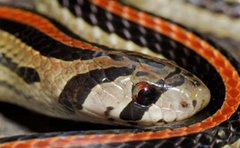During a late afternoon on 8 September 2007, Chan Kwok Wai found not one, not two, not three, but FOUR Oriental Whip Snakes (Ahaetulla prasina)!!!! One of the snakes was sighted at eye level, while the rest were encountered at the tree canopies. The green colour and long body length of this species, are perhaps adaptations for life at the canopy, since the former provides the snake with a good camouflage against aerial predators and the latter allows the snake to move from canopy to canopy.


From what I know, the Oriental Whip Snake is a popular pet. By disclosing the microhabitat of this snake, I fear that it will become easy target for potential poachers. Thus I would like to urge people to refrain from collecting this snake. I hope that information on the habit of this snake will instead allow us to understand its needs and eventually lead to better management of our few remaining forests.
More on this species here.






